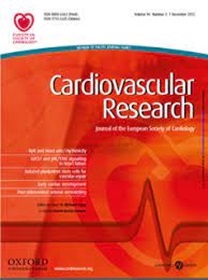尿毒症毒素硫酸吲哚酚在主动脉瓣狭窄病理生理中的作用
IF 13.3
1区 医学
Q1 CARDIAC & CARDIOVASCULAR SYSTEMS
引用次数: 0
摘要
目的慢性肾脏疾病(CKD)与心血管疾病(CVD)密切相关。这包括主动脉瓣狭窄(AS),成人中最常见的瓣膜疾病之一。CKD导致尿毒症毒素如硫酸吲哚酚(IS)的滞留,这是已知的诱导炎症和促钙化过程。我们假设IS特异性诱导AS形成。方法与结果用IS和磷酸盐刺激人瓣膜间质细胞(VICs)导致钙化增加。RNA测序发现裸角质层同源基因2 (NKD2)在尿毒症条件下的vic中表达上调。下调NKD2可降低vic的钙化和上调IL-6。有机阴离子转运多肽3A1 (OAT3A1)介导IS摄取以及NKD2和IL-6的上调。我们发现NF-κB信号参与了is诱导的IL-6上调。在体内,我们研究了腺嘌呤诱导的肾损伤模型或口服IS补充C57BL/6J小鼠丝损伤诱导的AS。超声心动图显示,与正常小鼠相比,导线损伤后尿毒症小鼠AS加重。与对照组相比,来自尿毒症小鼠AS的外植瓣膜显示巨噬细胞浸润,纤维化区域和瓣膜NKD2表达显著增加。与对照小鼠相比,is处理小鼠AS加重。在is处理小鼠的外植瓣膜中,伴随着更明显的瓣膜纤维化、巨噬细胞浸润和NKD2表达。在血液和骨髓中,IS治疗导致单核细胞分化为中间和非经典单核细胞。这与体外is诱导的单核细胞粘附瓣膜内皮细胞的结果是一致的。结论尿毒症通过诱导小鼠瓣膜纤维化和巨噬细胞浸润加重AS的发生。硫酸吲哚酚参与了这一过程,并刺激单核细胞分化和粘附到瓣膜内皮。在细胞水平上,我们假设is介导的NKD2诱导导致vic的钙化和炎症反应。本文章由计算机程序翻译,如有差异,请以英文原文为准。
The role of uremic toxin indoxyl sulfate in the pathophysiology of aortic valve stenosis
Aims Chronic kidney disease (CKD) is closely associated with cardiovascular disease (CVD). This includes aortic valve stenosis (AS), one of the most common valve diseases among adults. CKD leads to the retention of uremic toxins such as indoxyl sulfate (IS), which is known to induce inflammatory and pro-calcific processes. We hypothesise that IS specifically induces AS formation. Methods and Results Stimulation of human valvular interstitial cells (VICs) with IS in addition to phosphate led to increased calcification. RNA sequencing identified naked cuticle homolog 2 (NKD2) as an upregulated gene in VICs under uremic conditions. Knockdown of NKD2 reduced calcification of VICs and upregulation of IL-6. The organic anion transporting polypeptide 3A1 (OAT3A1) was identified to mediate IS uptake as well as upregulation of NKD2 and IL-6. We identified NF-κB signalling to be involved in IS-induced IL-6 upregulation. In vivo, we investigated combined models of adenine-induced kidney injury or oral IS supplementation with wire injury-induced AS in C57BL/6J mice. Echocardiography showed aggravated AS in uremic mice compared to control mice after wire injury. Explanted valves from uremic mice with AS exhibited a significant increase in macrophage infiltration, fibrotic areas and valvular NKD2 expression compared to controls. IS-treated mice showed aggravated AS compared to control mice. This was accompanied by more prominent valve fibrosis, macrophage infiltration, and NKD2 expression in explanted valves of IS-treated mice. In the blood and bone marrow, IS treatment led to the differentiation of monocytes into intermediate and non-classical monocytes. This was paralleled by IS-induced monocyte adhesion to valvular endothelial cells in vitro. Conclusion Uremic conditions aggravate AS development in mice by inducing valvular fibrosis and macrophage infiltration. Indoxyl sulfate is involved in this process and stimulates monocyte differentiation and adhesion to the valvular endothelium. On a cellular level, we hypothesize that IS-mediated NKD2 induction leads to a calcifying and inflammatory response in VICs.
求助全文
通过发布文献求助,成功后即可免费获取论文全文。
去求助
来源期刊

Cardiovascular Research
医学-心血管系统
CiteScore
21.50
自引率
3.70%
发文量
547
审稿时长
1 months
期刊介绍:
Cardiovascular Research
Journal Overview:
International journal of the European Society of Cardiology
Focuses on basic and translational research in cardiology and cardiovascular biology
Aims to enhance insight into cardiovascular disease mechanisms and innovation prospects
Submission Criteria:
Welcomes papers covering molecular, sub-cellular, cellular, organ, and organism levels
Accepts clinical proof-of-concept and translational studies
Manuscripts expected to provide significant contribution to cardiovascular biology and diseases
 求助内容:
求助内容: 应助结果提醒方式:
应助结果提醒方式:


